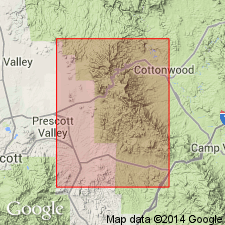
- Usage in publication:
-
- Gaddes basalt*
- Modifications:
-
- Original reference
- Dominant lithology:
-
- Basalt
- AAPG geologic province:
-
- Southwestern Basin-and-Range region
Summary:
Pg. 10-11, pl. 1. Gaddes basalt, basal formation of Ash Creek group (new) of Yavapai series. Forms black to dark-green outcrops. On unweathered surfaces basalt is dark green. Chiefly pillow lavas; local intercalated rhyolitic flows. Pyroclastic rocks of highly vesicular or amygdaloidal, irregular-shaped basaltic fragments resembling lapilli and small bombs appear in bodies of small size east of Mingus Mountain. Pillow structures range from 1 to 5 feet in length and average 1.5 to 2 feet. Estimated thickness in Black Canyon, 2,000 to 2,500 feet. Large outcrop on Mingus Mountain. Is metamorphosed in some areas. Weak foliation strikes east and dips steeply north. Underlies Buzzard rhyolite (new) of Ash Creek. Age is Precambrian (Yavapai). Report includes geologic map.
Good exposures in Gaddes Canyon, south of Mingus Mountain, and in Black Canyon, Jerome area, Yavapai Co., central AZ. Named from Gaddes Canyon, Yavapai Co., AZ.
Source: US geologic names lexicon (USGS Bull. 1200, p. 1449); supplemental information from GNU records (USGS DDS-6; Denver GNULEX).
For more information, please contact Nancy Stamm, Geologic Names Committee Secretary.
Asterisk (*) indicates published by U.S. Geological Survey authors.
"No current usage" (†) implies that a name has been abandoned or has fallen into disuse. Former usage and, if known, replacement name given in parentheses ( ).
Slash (/) indicates name conflicts with nomenclatural guidelines (CSN, 1933; ACSN, 1961, 1970; NACSN, 1983, 2005, 2021). May be explained within brackets ([ ]).

